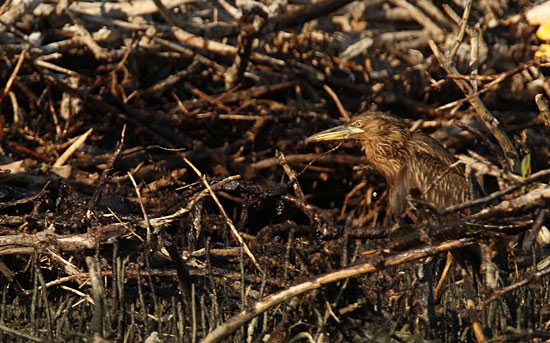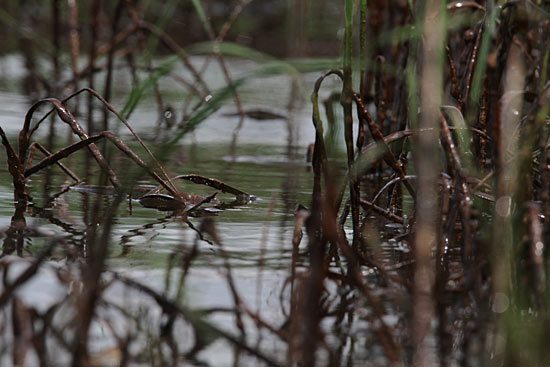Louisiana report: Oiled mangroves and the birds within (slideshow)
By Hugh Powell
June 29, 2010
















On Saturday we visited a few small mangrove islands in Bay Ronquille, south of Bay Jimmy, the place where thick oil in the saltmarsh grasses made the news early last week. Looking at a map, it must have been that same pulse of oil that washed over these islands. The worst part was seeing how the oil was slowly covering the several hundred pairs of wading birds and their chicks.
There was a saddening orderliness to the oiling here. Just like at the healthy rookery we saw at the Iron Banks, clean pelicans, egrets, spoonbills, ibises, and herons nested high among the broad leathery mangrove leaves. Hundreds of white-and-gray pelican chicks cast their prehistoric gaze over the bay, beside rusty-necked young Tricolored Herons and proud Great Egrets.
But nearly every bird down at the water’s edge was oiled. We saw at least 70 spoonbill chicks tinged bronzy orange and struggled to find any that were pink. Young Black-crowned Night-Herons were so stained that all but their yellow eyes vanished among the mangrove roots.
Oil coated 18 inches of saltmarsh grass and mangrove roots all the way across the narrow island. The oil seemed to have arrived on the high tide and then retreated, because there was a strip of unoiled mud and roots exposed beneath the heavy oil layer. All of these islands had been boomed, and the oil had just stained the booms brown on its way in.
The oil was at an awful height. As adults and young just out of the nest sidled through the oily mess, they picked it up on their shoulders and spread it yet more evenly as they preened. Birds that wandered into the dark interior of the island, seeking shade among the oily roots, just made matters worse.
Spoonbill chicks and White Ibises forage by probing in the mud, and thick brown stains on their bills suggested they had stirred up (and likely ingested) oil from the sediment. Egrets had every staining possibility imaginable. Some were white above with a thick, root-beer-colored “waterline” stain along their bellies. Others had covered their entire neck down to their shoulders. A few had just a thin ring around the neck, as if from sweeping through a small clump of oil while snatching at a fish.
As we circled each island, counting the damage, I couldn’t even find much relief in looking at the clean chicks higher in the trees. All too soon, these will clamber out of their nests and stand along the water’s edge, rubbing shoulders with the oil.
Sadly, rescuing these birds could do more harm than good. Though they’re undoubtedly being harmed by oil—compromising their feathers’ insulation and waterproofing, and suffering from oil ingestion—they’re still quite mobile and difficult to catch. Storming the island to rescue the oiled birds would frighten the healthy birds, possibly losing nests or stampeding clean birds into oily vegetation. And the sheer numbers of young birds needing help raises the practical question of how to save them without separating them from the parents they still need.
Yet all of these adults and many of the young can fly. It seemed nonsensical that these poor birds would continue to poke around their one grubby island, slowly making matters worse, when so many clean islands are available with just a short flight across the bay. I came almost to resent the egrets standing under their canopy of oiled roots, for being in the middle of a problem they simply didn’t recognize.
Perhaps this is why we watch birds, though; why we study the natural world at all. What other creature finds itself trapped in an oil-stained world, and chooses to walk in the same circles around the heart of the problem? When cleaner alternatives are already on the horizon, and only seem a bit too far away.
UPDATE: I contacted Michael Seymour, ornithologist for the Louisiana Dept. of Wildlife and Fisheries, to ask him about the state’s protocols for rescuing birds in colonies. He gave me a detailed response, which I’ve excerpted here for any readers wondering about rescue efforts in these difficult situations:
Our standard operating procedure states that “If the percentage of the colony oiled exceeds 50%, a team of at least three highly qualified biologists (ornithologists, species specific managers, etc.) from LDWF and USFWS will collaborate and develop a unified decision and protocol to remove the birds.” Fortunately, we have not reached oiling to this degree in any colony. It is never an easy decision nor is it taken lightly when we have to leave an oil impacted bird at a colony due to this disturbance issue. I share yours and others’ concern regarding the oil impacts at Bird Island # 2 (which I believe others are referring to as Cat Island). In addition to the colony disturbance, it was determined very early on that attempting to catch those oil impacted spoonbill chicks (and others) was greatly hindered by the structure of the mangroves themselves – namely that those same roots that are likely smearing oil on birds as they run through the island, act as significant barriers to human movement. That issue combined with disturbance means that the majority of birds rescued from that island must either be in the water (e.g., Brown Pelicans) or at an edge that is accessible and away from the colony – obviously a flighted bird adds to the difficulty!
Images by Benjamin Clock except #4 by Hugh Powell.

All About Birds
is a free resource
Available for everyone,
funded by donors like you
American Kestrel by Blair Dudeck / Macaulay Library
